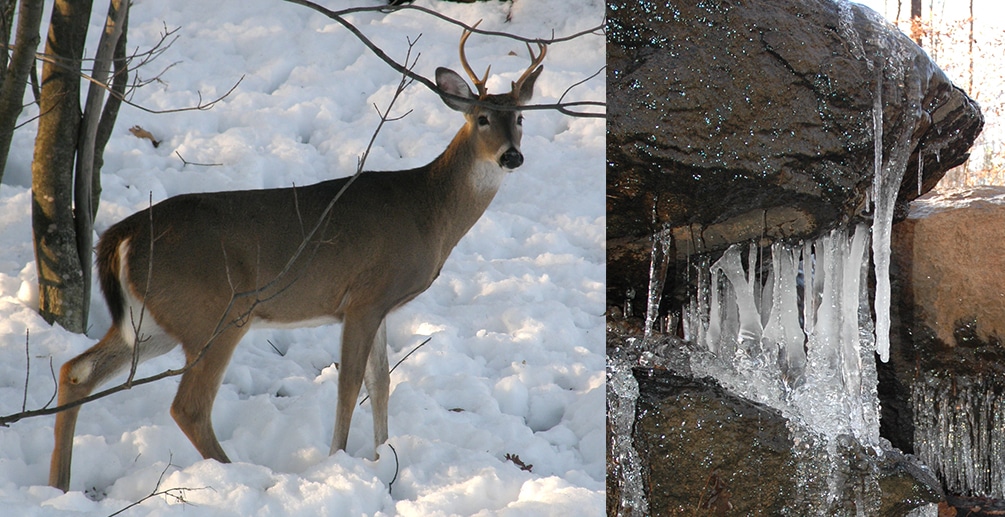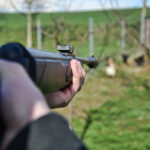The winter of 2017 has seen some pretty drastic temperature swings across North America. In fact, within the last 30 days we’ve seen air temperatures of 70 degrees at BWI airport in Baltimore, Maryland and 7 degrees just south of Birmingham, Alabama. When it’s warm out and water is available, deer get by no problem. However, what happens when the temperature drops and surface water begins to freeze? How do deer satisfy their basic daily requirement for water? Recently, I answered this question for an avid QDMA member in the #AskQDMA video shown above.
Deer get water from three major sources:
- Free water: These are natural bodies of water from puddles, streams, seeps, springs, lakes or ponds, as well as cattle troughs and other man-made catchments. Basically, liquid water you can see and touch.
- Preformed water: This is water found in food that deer eat. Its availability varies depending on the time of year and what vegetation is available. During spring and early summer the majority of a deer’s diet is comprised of forbs and other herbaceous material, which tend to be very succulent (high water content). When those types of plants disappear, what is left are plants that generally have less water in them – such as older leaves, needles, buds and twigs on woody shrubs and saplings.
- Metabolic water: This is water that is released from food during the digestion process as a result of oxidizing carbs, fats and protein found in plants.
It’s important to note that the reasons deer need water actually fluctuates throughout the year as well. Water consumption helps control some basic, year-round things for deer such as daily metabolic function, waste excretion, and transporting nutrients and minerals throughout the body. But there are other seasonal or age-related influences too, including gestation, lactation, thermoregulation(keeping ‘em cool in summer and warm in winter) and growth, for younger deer. Taking that into consideration, it’s safe to say deer need water most in spring and summer when biological and seasonal conditions warrant it. Luckily, this time of necessity coincides perfectly with a period when preferred foods are available and full of water.
Even when free water is abundant in any form, deer still satisfy most of their needs through preformed water, which is water in their food.
Deer will obviously stop, bend down like Bambi and drink free water any time its available. Or, they may eat snow in winter, too. However, even when free water is abundant in any form, they still satisfy most of their needs through preformed water. This is especially true in places with adequate precipitation, which is much of their natural range in North America.
When free water is scarce, such as in a severe drought or the extreme Southwest, deer are obviously forced to get almost all of their daily water requirements from the other two categories. As you probably noticed, each are directly related to diet. What’s interesting, though, is as their foods diminish in water content, the more they need water, just like you or I would need a big gulp of water after eating nothing but dry food for days on end. Thus, it’s a catch-22. The drier the food, the more they need water; but, during a drought there isn’t any or it occurs ata time when foods are low in water anyway. That’s why drought years impact deer productivity so much that you see drastic fluctuations in population and even antler size in arid regions, like south Texas. The lack of water limits their ability to thrive and grow.
What about in the extreme North? When all the free water is frozen, isn’t that just as tough as southern drought conditions? Not so much. It sure would take a lot of snow consumption to equal 8 ounces of water. But, because their overall water needs are reduced this time of year, and because deer get most of their water from foods they eat anyway, northern deer satisfy most of their winter water requirements by eating green needles within reach on coniferous trees, like hemlock and white cedar, the last year’s growth of buds and branches on numerous deciduous saplings and shrubs, live bark off both, and even acorns and other hard mast that they can find under the snow. During winter, northern deer also have the unique ability to recycle their urine and dry their feces internally to conserve water as well. Pretty neat.
So, the next time you see a news clip of a deer stuck on the ice and hear the anchor mention the deer must’ve been looking for water – just yell “hogwash” at the screen! He or she must have water on the brain.











































![Air gun 101: The differences between .177 & .22 – Which jobs they do best ? [Infographic]](https://airgunmaniac.com/wp-content/uploads/2024/11/1773-150x150.jpeg)
